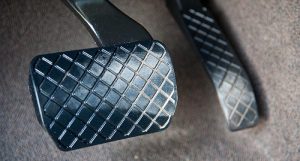Vehicles with power steering pump-powered hydroboost brake systems.
Condition
Pedal kickback, grabbing brakes, increased pedal effort, hissing noise while applying brakes or increased steering effort.
Cause
Possible contamination of hydroboost system due to deteriorating hoses, contaminated fluid or steering unit failure.
Solution
It may be possible to restore proper operation by flushing the system using the following procedure. An in-line filter MUST be used during the cleaning cycle. After cleaning, if the filter and fluid show obvious signs of hose contamination, all hoses must be replaced and both fluid and the in-line filter changed again.
Service Procedure
1. Chock and hold vehicle with hand brake.
2. Check the power steering pump fluid level; fill as necessary and do not over fill.
3. Start the engine. Let it idle and reach operating temperature.
4. Raise idle to 2200 rpm and maintain throughout test.
5. Pump brake pedal firmly 25 times.
6. Turn steering wheel lock-to-lock 5 times.
7. Hold at 2200 rpm for 15 seconds then allow engine to return to idle.
8. At idle, turn steering wheel lock-to-lock 3 times without applying brakes. If hard effort or binding is noticed repeat steps 3 through 6 once. If proper operation is not restored go to step 10. Complete steps 10 thru 12, perform necessary repairs, and repeat from step 1.
9. Test brakes for proper operation before moving vehicle, then drive vehicle 5 to 10 mph. Apply brakes to full stop verifying booster operation and steering action.
10. If brakes do not grab and steering effort is normal, shut off engine, allow system to cool then inspect in-line filter. If hose debris or contamination is found, hoses and fluid should be replaced and test repeated.
11. If grabbing is felt, pedal is hard or pedal stays down, check power steering pump before replacing the booster.
12. If steering effort is affected, power steering pump and steering unit tests must be performed.
Courtesy of Cardone ProTech.















